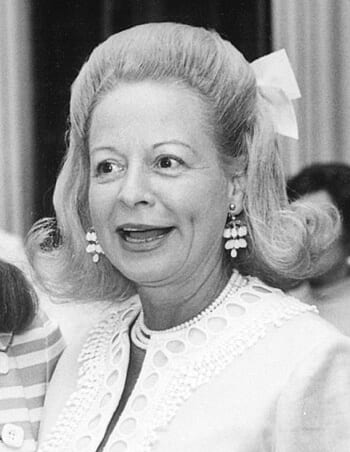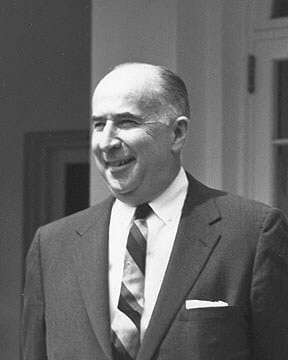When Martha Mitchell Was Right About Watergate

Martha Mitchell attends a White House social event in 1969. (Source)
May 31, 2021 ~ By Shari Rose
Martha “The Mouth” Mitchell Was Always Talking – Until the Nixon Administration Silenced Her
Martha Mitchell rapidly became a household name during Richard Nixon’s presidency due to her controversial public statements and natural ability to produce an electrifying story for the press. As the wife of John Mitchell, U.S. attorney general and eventual head of CREEP, Martha relished her close ties with some of the Republican party’s biggest stars in Washington. However, in the immediate aftermath of the Watergate break-in, Mitchell’s insider knowledge threatened Nixon to his core. In an effort to cover-up the White House’s involvement in Watergate, the Nixon administration waged an all-out war against her credibility – and it worked. This is the story of Martha “The Mouth” Mitchell, and how she fought to keep talking.
Martha Beall was born in Pine Bluff, Arkansas in 1918. She graduated college and began teaching the 7th grade before quickly realizing she didn’t like being a teacher. She found work as a receptionist and met John N. Mitchell, a Manhattan lawyer. They married in December 1957 and had one daughter together named Marty.
John Mitchell became Richard Nixon’s campaign manager in 1968. After Nixon won the presidency the following year, he chose Mitchell as U.S. Attorney General. As a staunch conservative and lifelong Republican, Martha was a big fan of Nixon’s self-proclaimed “law and order” policies, and excitedly joined John as they headed for Washington, DC.
Martha Mitchell’s Inflammatory Public Statements
Martha Mitchell was known in her social circles for her quick wit and Southern charm. When she reached Washington, her boisterous personality found a home with the Republican elite. She held a very busy social schedule, with numerous lunches, events, and parties with Washington’s biggest political stars.
Mitchell also personally organized many social events with the other wives of Cabinet members. Traditionally, Cabinet wives did not make the evening news, and they certainly did not speak to the press of their own accord. But Martha Mitchell was different. Free-speaking, blunt, and impulsive, she quickly made a name for herself with controversial and often outlandish statements about political opponents.
In one of her earliest public statements, Mitchell called anti-war protesters “liberal communists” on CBS Morning News in November 1969. In another example, she condemned peaceful protesters and appeared to bemoan the recent Civil Rights movement:
“Any time you get somebody marching in the streets, it’s catering to revolution. It started with the colored people in the South. Now other groups are taking to the streets. We could have worked out the integration battle without allowing them to march.”
To the delight of conservatives across the country, Martha Mitchell accused liberals of communism and attacked universities for their perceived liberalism. As a result, her clout in Republican circles grew.
Martha Mitchell Gains Heavy Media Coverage
Mitchell basked in media attention and the notoriety it offered her. As the wife of the U.S. attorney general, everything she said had political weight. So, Martha Mitchell was covered extensively in the press, with a gaggle of reporters eagerly waiting to see what she would say next. Time Magazine wrote of Mitchell in 1970:
“Martha’s trademark is her mouth, literally and metaphorically. Agape with laughter and framed in dimples, it dominates the Washington social scene—cocktail parties, state dinners. White House functions, ladies’ luncheons—and shoots off for appreciative newsmen, telling it as Martha thinks it is.”
President Richard Nixon adored Mitchell’s knack for gaining media coverage with her statements that supported his policies and views. He famously said to her, “Give ‘em hell.”
Martha Mitchell began meeting and befriending many DC reporters. She invited them to dinners and events, and was totally in her element. The reporters adored her salaciousness and natural ability for saying something that made a great headline. Mitchell’s obsession with the media was a symbiotic relationship: She reveled in the publicity, and reporters found her to be an entertaining, yet divisive figure that produced eye-grabbing stories in the paper.
- More stories: Right-Wing Attacks on No-Fault Divorce – A Dangerous Reality for Women
- More stories: How a Retractable Syringe Exposed Powerful Group Purchasing Organizations
- More stories: America Has The Highest Maternal Mortality Rate Among Western Nations
As a result, Martha “The Mouth” Mitchell quickly became a household name during the Nixon administration. In fact, one Gallup poll in November 1970 found that her name was recognized by 76 percent of the American public, a rare feat unheard of for a woman in public life in this era of American history.
CREEP and the Watergate Break-In
In March 1972, John Mitchell resigned as Attorney General and took over the Committee for the Re-Election of the President (CRP, or CREEP, as it is known today).

U.S. Attorney General John Mitchell in 1970. (Source)
On June 17, 1972, five burglars broke into the Democratic National Committee’s headquarters at the Watergate complex in Washington, DC. Soon after the break-in started, a security guard named Frank Wills noticed unusual activity in the building. He called the police, and all five men were arrested at Watergate that night.
The night of the Watergate break-in, Martha and John Mitchell were in Newport Beach, CA. They had traveled to California with their 11-year-old daughter the week prior to attend a flurry of Nixon campaign events. After the burglars were arrested, John received a call. He abruptly flew back to Washington, telling his wife to stay in their motel villa with their daughter.
Unknown to Martha, John instructed head security guard and former FBI agent Steve King to prevent his wife from reading newspapers or speaking on the phone while he worked on the cover-up in DC. James McCord, one of the Watergate burglars, was in charge of Martha’s security detail at the time of the burglary.
Martha Mitchell’s Kidnapping at Newporter Inn
While continuing her stay at the Newporter Inn with her daughter, Marty, Martha eventually managed to get hold of a newspaper at the motel. She learned of James McCord’s involvement in the break-in and realized that she unwittingly had far closer ties to the Watergate scandal than she originally thought.
Five days after the Watergate break-in, Martha Mitchell called UPI reporter Helen Thomas from her California motel room. She told Thomas that she gave John an ultimatum to leave politics entirely, saying she was “sick and tired of the whole operation.” While speaking to Thomas, Steve King ran into the room, threw her back across the bed, and tore the phone from the wall.
Thomas immediately attempted to call back, but reported that the hotel operator told her that Martha Mitchell was “indisposed.”
Mitchell realized she was being held at the Newporter Inn against her will, and tried to escape the motel villa multiple times. In one incident, she tried to climb from the balcony off the master bedroom onto an adjacent balcony one room over. She said King ran through the bedroom, pulled her back in, and kicked her. Mitchell said she was “batted around, kicked and manhandled” for the next several hours.
After Mitchell hung up on Helen Thomas, the reporter called John Mitchell, who had returned to DC and was staying at the Watergate. In response to Martha’s allegations that she was being held in California, John said to Thomas: “That little sweetheart. I love her so much. She gets a little upset about politics, but she loves me and I love her and that’s what counts.”
- More stories: When Columbia Expelled Robert Burke for Anti-Nazi Protests in 1936
- More stories: Israel Has Killed a Record-Breaking Number of Journalists in 6 Months
- More stories: Reckless Eyeballing: How Matt Ingram’s Story Reveals Fear of Black Sexuality
Mitchell Forcibly Sedated in California Motel
The morning after Steve King attacked Martha Mitchell, she attempted another escape. She made it downstairs before King spotted her near a glass door. He grabbed Mitchell, but her hand was cut badly in the struggle and required stitches. By this time, more security personnel had arrived at the Newporter Inn for the purpose of keeping Mitchell from speaking to the outside world as her husband worked on the cover-up.

Steve King in 2017 photo. (Source)
To treat her hand injury, they called a doctor to her villa. The doctor, Dr. Dan Kirkman, later said that he arrived at her villa and saw five or six security men in there. Mitchell later told reporters that she recognized two of the men as FBI agents, but the FBI has vehemently denied any involvement in her kidnapping.
One of the men told him to sedate Mitchell, and Dr. Kirkman initially refused. However, the men convinced him that she was just a hysterical alcoholic who accidentally injured herself. Over Mitchell’s protests that she was being held against her will, the doctor forcibly sedated her as security personnel held her down.
Upon hearing about the chaos at the motel room, Herbert Kalmbach flew to Newport Beach and met with Martha at John’s request. Kalmbach then called his personal physician, who successfully convinced him to take Mitchell to a hospital for her cut hand. After treatment, she convinced Kalmbach to have Steve King take Marty back to DC.
The following day, Martha Mitchell flew to the Westchester Country Club in Rye, NY. She reconnected with Helen Thomas at the UPI and told her everything.
Mitchell Speaks About Kidnapping at Westchester Club
When Thomas’ story published, reporters swarmed the New York country club. Mitchell told the gaggle of press that she was a prisoner in that California motel. She famously concluded, “I won’t stand for this dirty business.”
In the privacy of her room, Mitchell chose to speak to one member of the press, a crime reporter named Marcia Kramer from the New York Daily News. After meeting with her, Kramer said that Mitchell appeared to be a “beaten woman,” and the bruises on her arms looked like they were a “professional job.”

A story by Helen Thomas about Martha Mitchell’s kidnapping in California. (Source)
With the combination of Thomas’ and Kramer’s stories about Martha Mitchell, the Nixon White House realized it had another problem on its hands. If the public took Mitchell’s story seriously, reporters would continue to dig. If the Watergate cover-up had any chance of succeeding, Mitchell’s words would have to be made untrustworthy to the American people.
- More stories: Marshall Sherman’s Capture of Virginia Battle Flag at Gettysburg
- More stories: Esther Jones: Betty Boop’s Original Influence
Nixon’s Disinformation Campaign Against Martha Mitchell
Anonymous sources in the White House immediately began spreading rumors that Mitchell was headed for a mental institution and already had multiple emotional breakdowns. Literally one day after Mitchell’s “dirty business” comment, a staffer for CREEP was quoted in the press saying, “Everyone knows that Mrs. Mitchell has her private, personal problems. These are things only her husband can solve. She can be perfectly charming and then at other times—especially at night—she is not herself.”
White House aides claimed Mitchell’s story was the rantings of a mentally ill woman. They denied she had ever been beaten and accused her of being an out-of-control alcoholic.
Many, if not all, DC reporters took the bait and published unfounded stories from the White House that Martha Mitchell was mentally unfit and could not be trusted. Her credibility obliterated, no one in government nor the press took her claims about what happened to her seriously.
Even Pat Nixon, the nation’s First Lady, publicly commented on the state of Mitchell’s mental health, saying that the “exhaustion” of the Washington lifestyle had gotten to her.
John Mitchell Resigns From CREEP
On July 1, 1972, John Mitchell resigned as head of CREEP, two weeks after the Watergate break-in. He wrote in his resignation letter to Nixon that he chose to “meet the obligation which must come first: the happiness and welfare of my wife and daughter.”

A story by Helen Thomas about Martha’s ultimatum to John that he leave Washington politics. (Source)
However, a White House recording taken one day prior to his resignation later revealed that he and Nixon had colluded to use his resignation to help cover up the Watergate break-in. And before leaving the position, John promoted Steve King to head of security for CREEP, just days after he brutalized his wife in that California motel.
On September 10, 1972, Martha Mitchell wrote an open letter to Parade magazine in response to a piece they ran that questioned her allegations against King. She wrote, “Indeed it was Steve King that not only dealt me the most horrible experience I have ever had – but inflicted bodily harm upon me.”
She went into detail about the physical abuse she sustained, forced sedation by the doctor, and the hand injury she sustained. She ended her letter with: “This is just to set part of the record straight. I refuse to let these lies be told.”
The following day, Martha and John Mitchell moved from Washington, DC to New York.
John Beats Martha In Their Apartment
During the night November 1, 1972, Martha called Winzola McLendon, a reporter and her friend, in a panic. “Winnie, come help me!” she screamed over the phone.
McLendon and her husband, a Navy captain, rushed to the Mitchells’ apartment. John answered the door, looking disheveled and flushed. He let the McLendons in, and promptly went upstairs. McLendon’s husband stayed in the living room while Winzola and Martha talked privately.
- More stories: The Triumphs of Edward Gardner at the 1928 Bunion Derby
- More stories: Jovita Idár’s Fight for Mexican-American Rights in Texas
- More stories: Book Banning in the U.S. at an All-Time High
One of Martha’s front teeth was knocked out and bruises were already forming on both her arms. She and McLendon talked for hours that night. Martha Mitchell told her she was “scared to death” of her husband and frightened of what the Nixon administration may do to her after what happened in California. When McLendon asked why so many people wanted to hurt her, Mitchell replied, “Because I know so much, Winnie.”
Six days later, Richard Nixon was re-elected to a second term in office.
Smear Campaign To Ruin Mitchell’s Credibility Rages On
In May 1973, John Mitchell was indicted for his actions in the Watergate scandal. Blindsided and genuinely unaware of the extent of his crimes, Martha initially defended her husband in the press. When asked point-blank if she thought John was guilty, Martha responded, “I trust, and I pray to God.”
Recognizing the threat that Martha Mitchell continued to pose to the Nixon administration, the White House and Republican Party went into overdrive to discredit her. On June 21, 1973, The Madison Capitol Times reported that “Republicans in the highest places have been inferring that Mrs. Mitchell has had a nervous breakdown.”
Unnamed White House sources and members of Nixon’s own family leaked false information to reporters that Mitchell had been institutionalized and was having hallucinations. Reporters wrote these bad-faith claims in the paper as fact, and Mitchell’s credibility was inextricably ruined. Nothing she said about California, Steve King, or Watergate was taken as truthful, and her accurate statements about the crimes the Nixon administration committed were ignored.
Out of desperation, Martha Mitchell regularly attempted to hand over sensitive documents pertaining to Watergate and the Nixon administration to the Special Prosecutor’s office. However, the office never responded to her, so she turned to the Washington Post. She gave reporters official documents that produced salacious stories about the Nixon White House and its attempts to cover up past crimes. However, the Washington Post kept Mitchell as an anonymous source, all-but ensuring that her credibility remained in tatters.
In an interview during this period, Martha Mitchell said, “I have been at the mercy of the White House for four years.” She went on to say that White House staffers “treated me abominably, half-crucified me, have sent out lies through the press.”
Mitchell’s Claims Are Slowly Corroborated After Nixon Resigns
After a 16-year marriage, Martha and John Mitchell separated in September 1973. The following year, Dr. Dan Kirkman, the doctor who had drugged Mitchell in California, confirmed in an interview that Mitchell was held against her will by men who worked for the Nixon White House. Still, no investigation into her claims followed. Mitchell continued to live in political exile, with her integrity lost to a successful disinformation campaign from the Nixon administration.
Finally, with impeachment proceedings closing in and his inner circle under indictment, Richard Nixon announced his resignation from the presidency on August 8, 1974.
In February 1975, James McCord admitted in an interview that Mitchell was telling the truth about what happened at the California motel. McCord, who had been convicted of multiple counts of conspiracy, burglary, and wiretapping, spoke to The New York Times:
“Martha’s story is true—basically the woman was kidnapped,” McCord said. He continued, “I think that Martha was ignorant of most of his activities. Shocked is probably more proper. John Mitchell didn’t want her to know.”
That same month, John Mitchell was found guilty of conspiracy, obstruction of justice, and perjury due to his actions in the Watergate scandal. He served 19 months in a minimum security prison.
No one was ever charged in the 1972 kidnapping of Martha Mitchell. Steve King continued his career in politics, and eventually became ambassador to the Czech Republic under Donald Trump.
Two years after escaping the Newport Beach motel, she said, “I never forgave John Mitchell for what he let them do to me in California.”
- More stories: Yuri Kochiyama At The Intersection of Black Power & Asian Movements
- More stories: Masako Katsura: Japanese Billiards Player Who Broke Gender Barrier
- More stories: John Mitchell Jr.’s Relentless Fight For Justice At The Richmond Planet
Martha Mitchell’s Death & Legacy
In late 1975, Mitchell fell ill. She was eventually diagnosed with multiple myeloma, a type of cancer that attacks plasma cells. Mitchell spent her final days in relative obscurity and died on May 31, 1976. At her funeral, an anonymous supporter sent a large floral arrangement that read, “Martha Was Right.”
In 1977, Richard Nixon spoke in an interview about the Watergate scandal and Martha Mitchell’s influence on its unraveling. He concluded bitterly to a reporter, “If it hadn’t been for Martha, there’d have been no Watergate.”

The anonymously donated “Martha Was Right” flower arrangement stands at Martha Mitchell’s 1976 funeral. (Source)







Terrific article, Ms. Rose, you really nailed the politics behind the attacks on Martha Mitchell and why the Nixonians had to discredit her.
And kudos on the research. I’ve also written about Martha Mitchell and researched her, but didn’t know the name of the doctor in Newport Beach.
If you get the chance, please check out my article at https://www.necessarystorms.com/home?category=Mitchell and let me know your thoughts and criticisms. I’m in my 60s and lived through that era and well remembered how MM was portrayed by the media.
Shirley, thank you so much for your kind words. What happened to Martha Mitchell is quite a difficult story to research, as you know, but well worth it. I really enjoyed your piece as well, especially the deep dives you took into what some of Nixon’s people were up to after the break-in. Their actions certainly played a role in silencing Mitchell as well. Thanks again for reaching out!